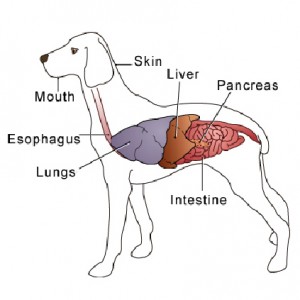 The pancreas is an organ found near a dogs liver and intestine. The pancreas consists of two different types of pancreatic tissues which are mixed together throughout the organ. The pancreas plays a key role in many processes of the body including the production and release of digestive enzymes (produced by one type of pancreatic tissues) and hormones responsible for glucose regulation (produced by the other type of pancreatic tissues). Digestive enzymes, amylase, lipase, proteases and others) are released from the pancreas into the small intestine. The enzymes aide digestion. When these enzymes are damaged or lacking, the inadequate amount of good enzymes result in malnutrition, known as Excocine Pancreatic Insufficiency (EPI) despite the dog having a good appetite and good nutrition. EPI is also known as maldigestion of malabsorption.
The pancreas is an organ found near a dogs liver and intestine. The pancreas consists of two different types of pancreatic tissues which are mixed together throughout the organ. The pancreas plays a key role in many processes of the body including the production and release of digestive enzymes (produced by one type of pancreatic tissues) and hormones responsible for glucose regulation (produced by the other type of pancreatic tissues). Digestive enzymes, amylase, lipase, proteases and others) are released from the pancreas into the small intestine. The enzymes aide digestion. When these enzymes are damaged or lacking, the inadequate amount of good enzymes result in malnutrition, known as Excocine Pancreatic Insufficiency (EPI) despite the dog having a good appetite and good nutrition. EPI is also known as maldigestion of malabsorption.
In most cases it is only the tissues of the pancreas responsible for digestion that are destroyed. In a minority of cases the endocrine pancreas tissue, responsible for glucose regulation is also affected. If this is the case then the dog will develop diabetes, known as Endocrine Pancreatic Insufficiency.
EPI seems to have a genetic basis but is not congenital. It may develop at any age, although usually shows up before 4 years of age. The disease seems to be autosomal recessive, which means that carriers will appear normal. It is commonly found in German Shepherd Dogs and Rough Collies. Although Basenjis can be affected by this disease it is certainly not prolific.
Posted in: Health & Wellbeing, Pancreatic Insufficiency
